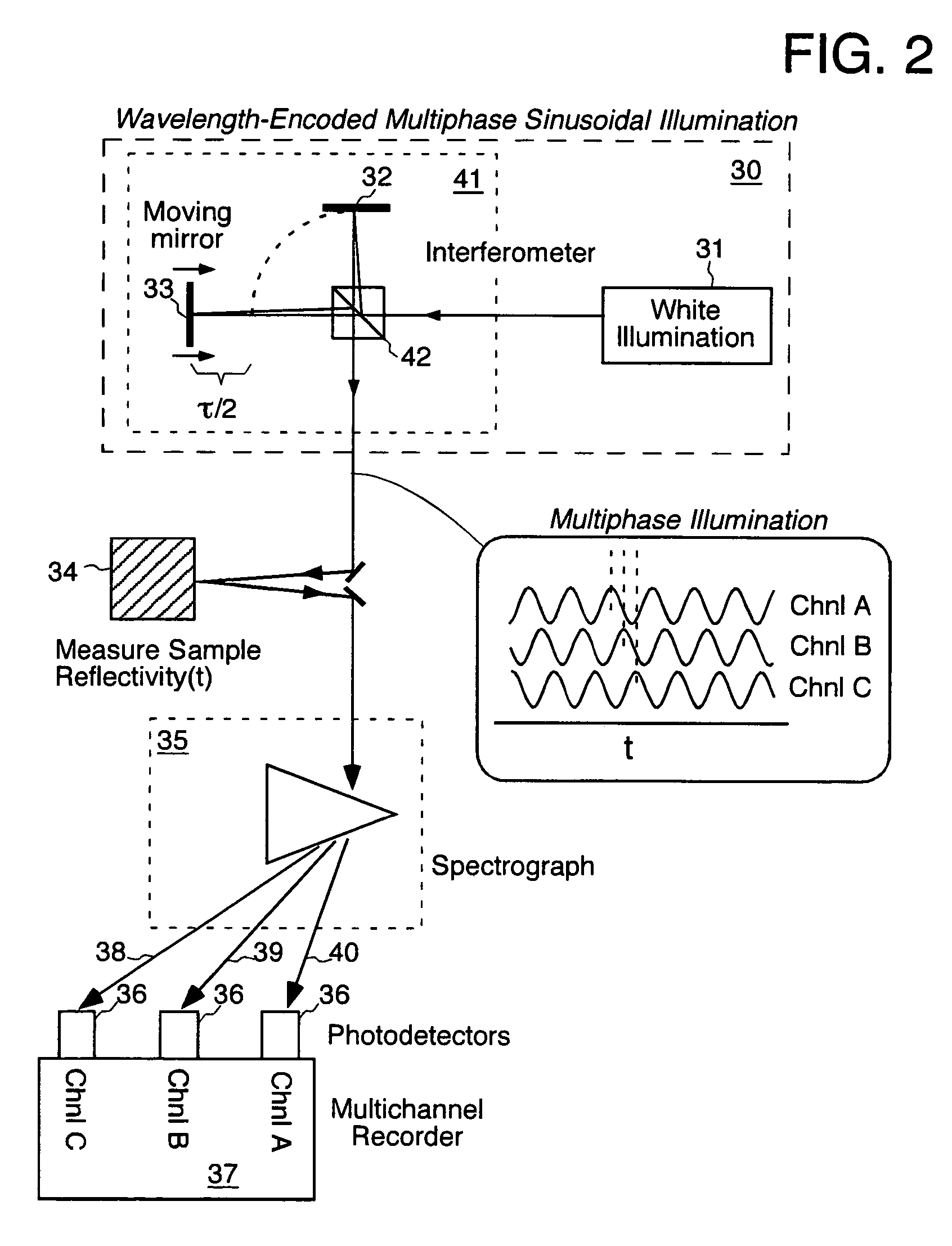[0013] One aspect of the present invention includes a method for increasing the
temporal resolution of an
optical detector measuring the intensity versus time of an intrinsic optical signal S0(t) of a target having frequency f, so as to enhance the measurement of
high frequency components of S0(t), said method comprising: illuminating the target with a set of n phase-differentiated channels of sinusoidally-modulated intensity Tn(t), with n≧3 and modulation frequency fm, to produce a corresponding set of optically heterodyned signals S0(t)Tn(t); detecting a set of signals In(t) at the
optical detector which are the optically heterodyned signals S0(t)Tn(t) reaching the
detector but blurred by the
detector impulse response D(t), expressed as In(t)={S0(t)Tn(t)}{circle around (×)}D(t)=Sord(t)+In,osc(t), where Sord(t) is an ordinary signal component and In,osc(t) is an oscillatory component comprising a down-shifted beat component and an up-shifted conjugate beat component; in a phase stepping analysis, using the detected signals In(t) to determine an ordinary signal Sord,det(t) to be used for
signal reconstruction, and a
single phase-stepped complex output signal Wstep(t) which is an isolated single-sided beat signal; numerically reversing the optical heterodyning by transforming Wstep(t) to Wstep(f) and Sord,det(t) to Sord,det(f) in
frequency space, and up-shifting Wstep(f) by fM to produce a treble spectrum Wtreb(f), where Wtreb(f)=Wstep(f−fM); making the treble spectrum Wtreb(f) into a double sided spectrum Sdbl(f) that corresponds to a real valued signal versus time Sdbl(t); combining the double sided spectrum Sdbl(f) with Sord,det(f) to form a composite spectrum Sun(f); equalizing the composite spectrum Sun(f) to produce Sfin(f); and inverse transforming the equalized composite spectrum Sfin(f) into
time space to obtain Sfin(t) which is the measurement for the intrinsic optical signal S0(t).
[0014] Another aspect of the present invention includes A
computer program product comprising: a computer useable medium and computer readable code embodied on said computer useable medium for causing an increase in the
temporal resolution of an
optical detector measuring the intensity versus time of an intrinsic optical signal S0(t) of a target having frequency f, so as to enhance the measurement of high frequency components of S0(t) when the target is illuminated with a set of n phase-differentiated channels of sinusoidally-modulated intensity Tn(t), with n≧3 and modulation frequency fM, to produce a corresponding set of optically heterodyned signals S0(t)Tn(t), and a set of signals In(t) is detected at the optical detector which are the optically heterodyned signals S0(t)Tn(t) reaching the detector but blurred by the detector
impulse response D(t), expressed as In(t)={S0(t)Tn(t)}{circle around (×)}D(t)=Sord(t)+In,osc(t), where Sord(t) is an ordinary signal component and In,osc(t) is an oscillatory component comprising a down-shifted beat component and an up-shifted conjugate beat component, said computer readable code comprising: computer readable
program code means for using the detected signals In(t) to determine an ordinary signal Sord,det(t) to be used for
signal reconstruction, and a
single phase-stepped complex output signal Wstep(t) which is an isolated single-sided beat signal; computer readable
program code means for numerically reversing the optical heterodyning by transforming Wstep(t) to Wstep(f) and Sord,det(t) to Sord,det(f) in
frequency space, and up-shifting Wstep(f) by fM to produce a treble spectrum Wtreb(f), where Wtreb(f)=Wstep(f−fM); computer readable
program code means for making the treble spectrum Wtreb(f) into a double sided spectrum Sdbl(f) that corresponds to a real valued signal versus time Sdbl(t); computer readable program code means for combining the double sided spectrum Sdbl(f) with Sord,det(f) to form a composite spectrum Sun(f); computer readable program code means for equalizing the composite spectrum Sun(f) to produce Sfin(f); and computer readable program code means for inverse transforming the equalized composite spectrum Sfin(f) into
time space to obtain Sfin(t) which is the measurement for the intrinsic optical signal S0(t).
[0017] The present invention enhances the ability of a detector to measure the high frequency components of a time varying signal S0(t) by sinusoidally modulating it at a frequency fM prior to its detection, and to do so at several values of modulation phase φn, where n is called a phase stepping index. The modulation process can be represented by a
transmission function Tn(t): Tn(t)=(0.5){1+γn cos(2πfmt+2πφn)} Eqn. xx3 which varies sinusoidally versus the independent variable “t” and is
phase shifted by φn, for the nth detecting channel of k channels. The (0.5) factor is unimportant here. The symbol γn is called the
visibility and represents the degree of modulation, which is ideally unity but in practice less than this. The present invention multiplies the intrinsic signal by Tn(t), prior to the blurring action represented by the
convolution in the following equation for the nth
data channel: In(t)={Tn(t)S0(t)}{circle around (×)}D(t) Eqn. xx4 A heterodyning effect occurs between the sinusoidal component of Tn(t) and S0(t), which creates up-shifted and down-shifted beat components. (The ordinary component Sord(t) is also produced.) The beat components are scaled replicas of S(f), but shifted in frequency, up and down, by amount fM. The up-shifted beat component is unlikely to survive detector blurring D(f). The down-shifted beat component in
frequency space is: Wbeat(f)=(0.5)γS(f+fM)D(f) Eqn. xx5 The down-shifted beats manifest high frequency information moved optically toward lower frequencies, where they are more likely to survive detector blurring. The present invention measures these beats, and then numerically reverses the heterodyning process during
data analysis to recreate some of the original high frequency information. This is done by shifting the frequencies upward by fM, forcing the output to be purely real, and dividing out D(f) where appropriate.
[0018] Thus the present invention is capable of measuring frequencies near fM at better sensitivity than the detector used without modulation. If fM is chosen to lie on the shoulder of the ordinary response D(f) curve, then the
effective frequency response of the instrument that combines the processed beat information with the ordinary signal, is expanded beyond D(f). Since resolving power is proportional to
frequency response, the invention can improve (boost) the temporal resolving power of a detecting
system, so that for the same record length a greater number of
effective time bins are manifested.
 Login to View More
Login to View More  Login to View More
Login to View More 


